- Sorry, this product is unavailable.
-

Munda Trail: Eric Hammel
$10.00The Solomon Island archipelago stretches in a roughly east-west direction from New Guinea to San Cristobal. For the Imperial Japanese forces in 1942, it was a natural highway into the South Pacific. When checked at Guadalcanal, these forces realized they had moved east too quickly, and that their defeat was caused in part by inadequate air bases between the front and their head-quarters at Rabaul, more than six hundred miles away. As the last Japanese battalions were wrecking themselves against the Marine defensive perimeter on Guadalcanal, the decision was made to build the Munda airfield on New Georgia, right in the middle of the Solomons chain. This is the dramatic, harrowing story of green American soldiers encountering for the first time impenetrable swamps, solid rain forests, invisible coconut-log pillboxes, tenacious snipers tied into trees, torren-tial tropical rains, counterattack by enemy aircraft and naval guns, and the logistical nightmare of living and moving in endless mud. -
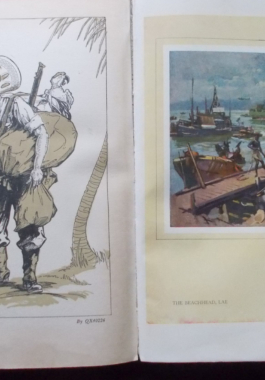
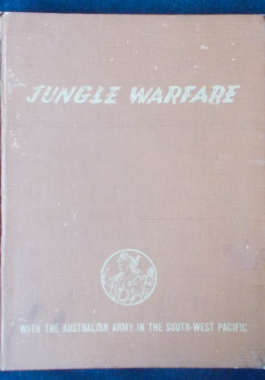
Published for the Australian Military Forces by the Australian War Memorial, Canberra, in 1944. Full of sketches, poems, colour plates and photographs, cartoons and jokes, as well as those fabulous yarns that Aussies can tell so well - and all by the service personnel who were engaged in the South West Pacific during World War II. Contributors are identified only by their service numbers...so your grandfather or great grandfather may be among the authors. Here we do not find battle statistics, plans or generals - just the down to earth Australian Diggers.
-
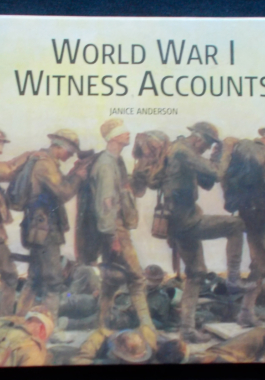 You can read history - or you can learn history from the people who lived it. This compilation of accounts of life during the First World War are from diaries and letters: from those at home, from the trenches, from men and women in the armed forces...there's even a section devoted to the modern machineries of war and what those on the front line thought of them. Here are the voices of that time and they are the ones who know what life was like then.
You can read history - or you can learn history from the people who lived it. This compilation of accounts of life during the First World War are from diaries and letters: from those at home, from the trenches, from men and women in the armed forces...there's even a section devoted to the modern machineries of war and what those on the front line thought of them. Here are the voices of that time and they are the ones who know what life was like then. -
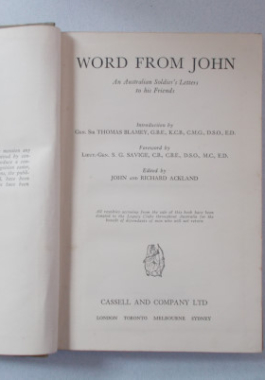
An Australian soldier's letters to his friends from World War II. When written, these letters did not mention place names other than those permitted by the censor. In order to make a continuous and intelligible narrative, these place names (now permitted) have been inserted. A rare glimpse from the war front.
-
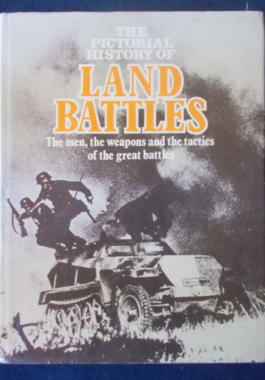 A book full of information, pictures and maps of land battles throughout history that proves it was not always about who had the biggest army. In this volume - Metaurus - after the toughest forced march in history, Nero slays Hasdrubal; Agincourt - massed archers and infantry slaughter the French cavalry; Bunker Hill - a thousand farmers ignite the flame of American independence; Austerlitz - Napoleon crushes an army bigger than his own; Balaclava - a battle of idiocy and sheer courage; Second Bull Run - a high spot for the South in the American Civil War; The Somme - slaughter on a scale never seen before or since; Cambrai - tanks explode into action for the first time; Gazala - Rommels' fast moving tactical brilliance; Stalingrad - Hitler's obstinacy leads the Wehrmacht to disaster; Cassino and Anzio - Allied forces combine to force a breakthrough; The Battle Of The Bulge - fast moving Panzers against Eisenhower, Montgomery and Patton; Operation Commando - a true 'United Nations; against the Chinese in Korea. Illustrated with archival photographs, artists' representations and maps.
A book full of information, pictures and maps of land battles throughout history that proves it was not always about who had the biggest army. In this volume - Metaurus - after the toughest forced march in history, Nero slays Hasdrubal; Agincourt - massed archers and infantry slaughter the French cavalry; Bunker Hill - a thousand farmers ignite the flame of American independence; Austerlitz - Napoleon crushes an army bigger than his own; Balaclava - a battle of idiocy and sheer courage; Second Bull Run - a high spot for the South in the American Civil War; The Somme - slaughter on a scale never seen before or since; Cambrai - tanks explode into action for the first time; Gazala - Rommels' fast moving tactical brilliance; Stalingrad - Hitler's obstinacy leads the Wehrmacht to disaster; Cassino and Anzio - Allied forces combine to force a breakthrough; The Battle Of The Bulge - fast moving Panzers against Eisenhower, Montgomery and Patton; Operation Commando - a true 'United Nations; against the Chinese in Korea. Illustrated with archival photographs, artists' representations and maps. -
 Shot down in 1942, young Australian fighter pilot John Williams DFC became a POW in the notorious Stalag Luft III camp in Germany. John had joined the air force shortly before the outbreak of war and, in the larrikin tradition, led his squadron into air combat over the deserts of Libya and Egypt dressed in sandals and shorts. John and his best mate Rusty Kierath were among the 76 POWs who tunnelled their way out of the supposedly escape-proof camp under the noses of their German guards in what later became the Hollywood blockbuster, The Great Escape. Their families never learned what really happened once the pair made it out into the forest. John's niece Louise Williams has pieced together his life, from his upbringing in a tight-knit family hit hard by the Depression, to his exploits in the air, and the many missing details of the tragic escape. It is a powerful and intimate story of one of the most dramatic episodes of World War II. Illustrated with black and white photographs.
Shot down in 1942, young Australian fighter pilot John Williams DFC became a POW in the notorious Stalag Luft III camp in Germany. John had joined the air force shortly before the outbreak of war and, in the larrikin tradition, led his squadron into air combat over the deserts of Libya and Egypt dressed in sandals and shorts. John and his best mate Rusty Kierath were among the 76 POWs who tunnelled their way out of the supposedly escape-proof camp under the noses of their German guards in what later became the Hollywood blockbuster, The Great Escape. Their families never learned what really happened once the pair made it out into the forest. John's niece Louise Williams has pieced together his life, from his upbringing in a tight-knit family hit hard by the Depression, to his exploits in the air, and the many missing details of the tragic escape. It is a powerful and intimate story of one of the most dramatic episodes of World War II. Illustrated with black and white photographs. -
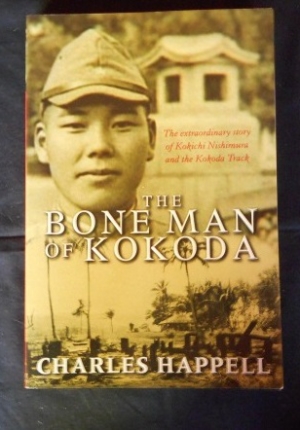
Kokichi Nishimura was a member of the 2nd battalion, 144th regiment of the Japanese Imperial Army. In 1942 he fought every foot of the Kokoda Track as the Japanese attempted to take Port Moresby and was the only man from his platoon to survive the campaign. Finally he retreated, wounded and starving, leaving thousands of his comrades buried in shallow graves along the Track. He promised that he would one day return to them and bring them home to Japan for proper burial. He married, had three children and started an engineering business which prospered. But his driving ambition was to return to New Guinea to keep his promise. In 1979, nearing retirement age, he shocked his family by giving his business to his sons, his house and all his assets to his wife and he returned to New Guinea to begin his search for the remains of Japanese soldiers. For the next 25 years Nishimura lived alone in huts and tents along the Kokoda Track and using a mattock, a shovel, a metal detector and an indomitable will, he found the bones of hundreds of his comrades and also forged a new comradeship and new purpose in helping the poverty-stricken Papuans he worked amongst. An incredible story. Illustrated with black and white photographs.
-
 The story closely follows key events of the Xinhai Revolution, with focus on Huang Xing and Sun Yat-sen. It begins with the Wuchang Uprising of 1911 and follows through historical events such as the Second Guangzhou Uprising on 27 April 1911, the deaths of the 72 martyrs, the election of Sun Yat-sen as the provisional president of the new Provisional Republic of China, the abdication of the last Qing dynasty emperor Puyi on 12 February 1912, and Yuan Shikai becoming the new provisional president in Beijing on 10 March 1912. Also known as Xinhai Revolution and 1911.
The story closely follows key events of the Xinhai Revolution, with focus on Huang Xing and Sun Yat-sen. It begins with the Wuchang Uprising of 1911 and follows through historical events such as the Second Guangzhou Uprising on 27 April 1911, the deaths of the 72 martyrs, the election of Sun Yat-sen as the provisional president of the new Provisional Republic of China, the abdication of the last Qing dynasty emperor Puyi on 12 February 1912, and Yuan Shikai becoming the new provisional president in Beijing on 10 March 1912. Also known as Xinhai Revolution and 1911. -
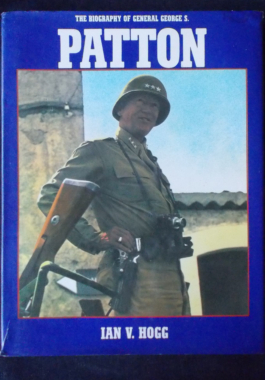
Patton's aggression and theatrical personality made his units the most successful and efficient and he believed that it should be his Army that should lead the Allied attacks. This brought him into constant conflict with Eisenhower and Montgomery, with Patton doing nothing to hide his belief that he would win the war if properly supported. He expected the same aggression from his men and was probably the best American field commander in the European theatre.


